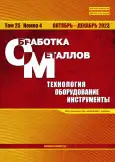Введение. В статье представлен всесторонний обзор методов производства, материалов, свойств и проблем, связанных с пенометаллами; особое внимание уделяется пенометаллам на основе алюминия и титана. Пористые пенометаллы вызывают интерес благодаря уникальному сочетанию низкой плотности, высокой жесткости и высокой способности поглощать энергию. Металлическая пена известна своим уникальным сочетанием физических и механических свойств, включая повышенную жесткость, удельную прочность при высоких температурах, легкий вес и эффективное поглощение энергии при относительно низкой площадке текучести. Пенометалл широко используется в автомобильной, судостроительной и космической промышленности. Он имеет высокую пористость, низкую относительную плотность и высокую прочность, что повышает эксплуатационные характеристики изделия. В аэрокосмической и автомобильной промышленности требуется материал с высоким соотношением прочности и удельного веса. Методы. Для удовлетворения этой потребности было разработано множество методов производства металлической пены, таких как метод расплавления, метод осаждения и метод порошковой металлургии. Метод литья широко используется для производства металлической пены по сравнению с другими методами. Результаты и обсуждение. При производстве пенометаллов на основе алюминиевого сплава обычно используется метод прямого вспенивания расплавов. Гидрид титана (TiH2) был популярным пенообразующим веществом, но высокая скорость его разложения и ограничения по стоимости привели к разработке альтернативных пенообразователей, таких как CaCO3 (карбонат кальция). Титановую пену часто изготавливают, используя наполнитель для формирования пор. Этот метод включает смешивание титанового порошка с наполнителем, формирование заготовки, а затем спекание для удаления наполнителя и создания пористой структуры, поскольку метод, основанный на использовании наполнителя для формирования пор, позволяет точно контролировать свойства пены, такие как размер пор, пористость и относительную плотность. Результаты также показывают, что пористость пенометаллов может варьироваться от 50 до 95 %, что совпадает с данными из литературы. Пористые структуры могут включать в себя открытые и закрытые поры, а также их комбинацию, из-за чего различные участки материала обладают разными механическими и термическими свойствами. В различных литературных источниках также отмечается, что относительная плотность, которая представляет собой отношение плотности пенометалла к плотности порошкового материала, варьируется от 0,02 до 0,44 в зависимости от используемого метода производства.
 6-21
6-21


 22-35
22-35


 36-60
36-60


 61-73
61-73


 74-89
74-89


 90-104
90-104


 105-116
105-116


 117-135
117-135


 136-150
136-150


 151-166
151-166


 167-179
167-179


 180-201
180-201


 202-215
202-215


 216-231
216-231


 232-243
232-243


 244-254
244-254


 255-267
255-267


 268-283
268-283








